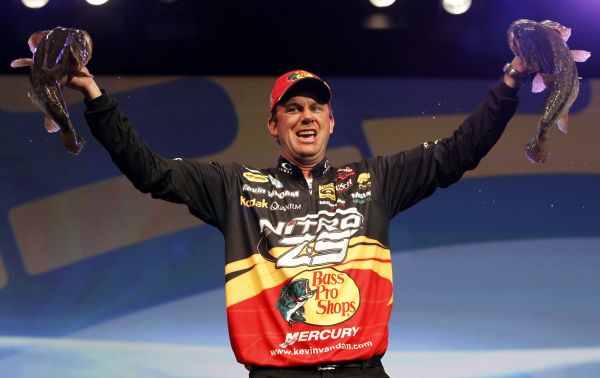
Electrofishing proves fish still available, LDWF says
Lake Cataouatche was 98 percent covered by hydrilla in 2007, and that mass of vegetation fueled a big-bass fishery that grabbed world attention in 2011 when Kevin VanDam won his fourth Bassmaster Classic by seining those grass beds for more than 69 pounds over three days of competition.
Now the vegetation that concentrated so many bass has vanished — and some say the fishing opportunities have disappeared along with the hydrilla.
Luling fisherman Steve Rockweiler said he began fishing Cataouatches in 1950s and saw it change over the years as saltwater intrusion and coastal erosion began bringing in different species of fish and forcing the freshwater varieties elsewhere.
But when the Corps of Engineers built the Davis Pond Freshwater Diversion to inject fresh water from the Mississippi River into the area, the ecosystem changed back to its original makeup.
Rockweiler said after freshwater again began flowing into estuary, freshwater fish populations, especially largemouth bass began to take off again.
“When they built the Davis Pond Diversion and started flowing water back into it in 2002 it got back to what it was in the ’50s and ‘60s,” he said. “It got back to the real good fresh water fishing.”
Around 2007 the Corps of Engineers made some alterations to the freshwater diversion by adding additional canals to feed freshwater in the lake straight from the Mississippi River. And the hydrilla covering the lake began dying off.
“We were just getting some interest in how this place can be a world-class fishery for seven or eight years, and now it’s the Dead Sea,” Rockweiler said. “I’ve got people all over the country calling me wanting to come in (to fish Cataouatche), and I am not going to tell them to come in here.”
Melissa Kaintz, operations manager for the inland fisheries section of Louisiana Wildlife and Fisheries, said that that changes made by the Corps, while not been proven to be the cause of the shift in the eco-system, are a very likely culprit.
“We can at this point only speculate that (the die-off of hydrilla) does seem to coincide to increased use of the Davis Pond Freshwater Diversion and some modifications that were made to that project,” Kaintz said.
Kaintz said additional inflows of Mississippi River water into the lake without passing through the sedimentation pond have likely led to infiltration of muddy water that blocks out sunlight hydrilla needs to thrive.
“The turbid water blocks out any sunlight from penetrating to the water column ,and hydrilla and other aquatic vegetation need sunlight to grow,” she said. “The more turbid that water stays, if it doesn’t clear up at all during the growing season then (vegetation) won’t grow.”
Some local fisherman have claimed the LDWF is responsible for the loss of vegetation on the lake because past herbicide treatments of the hydrilla.
Kaintz said that, while WLF did treat parts of the hydrilla, they only did so to create thoroughfares for boaters, and she said the agency has not treated the area since.
“The last time Wildlife and Fisheries or anyone that we know of treated aquatic vegetation was in 2007, and at that point the lake was about 98 percent covered,” she said. “We were getting complaints that people couldn’t even drive their boat through the lake.”
Luling’s Bruce McDonald has been fishing the area for decades, and said Classic champion VanDam loved fishing the lake.
“The fishery used to be unbelievable,” McDonald said. “I rode in the Bassmaster’s Classic when VanDam won it.
“He said it was the best fishery in North America, and we went from a 10 to zero in three and a half years.”
In McDonald’s opinion, the problem with Lake Cataouatche is due to a number of variables, including increased pollutants from allowing more of Mississippi River water to come in to different areas.
“The lake looks big, but it is only 6 miles long by 4 miles wide. When you start combining all of the impacts, something is going to give,” McDonald said. “The Corps supposedly did something; combine that with pollution, overfishing, water clarity — a lot of factors have combined to hurt that lake.”
At the same time, McDonald said there are fish in the lake, but the disappearance of the vegetation has kept anglers away.
“I fished it earlier this week and did real well, but at the same time there was nobody on the lake,” he said. “I had it all to myself. It used to be they would have 100 boats out there.”
Kaintz backed up McDonald’s contention that the bass haven’t simply evaporated; she said the most-recent electrofishing studies showed there has not been a decrease in the fishery population.
“We’ve been doing a pretty extensive study out there on largemouth bass over the past three years, and we have not seen a decrease in the population,” she said.
She said the harvest rate at Lake Cataouatche has been low over the past few years, a fact that should provide plenty of opportunities to catch largemouth bass in the area for those anglers who ignore the absence of hydrilla.
However, Kaintz said that, because the ecology of the area has changed, anglers might have to adjust their approach to catching largemouth bass.
“We can understand how it would be more difficult to catch fish because there are not these grass beds where they can target the fish. So the fish are more randomly spread out, and it is harder to target those bass,” she said.
Kaintz said while it seems unlikely the hydrilla will make a comebac anytime soon, there is some good news for other local bodies of water.
“There is not much we can do about (the Cataouatche situation), (but) I have heard some reports that (anglers) are starting to see grass growing in Lake Salvador,” she said. “There may be more of shift in the area.”